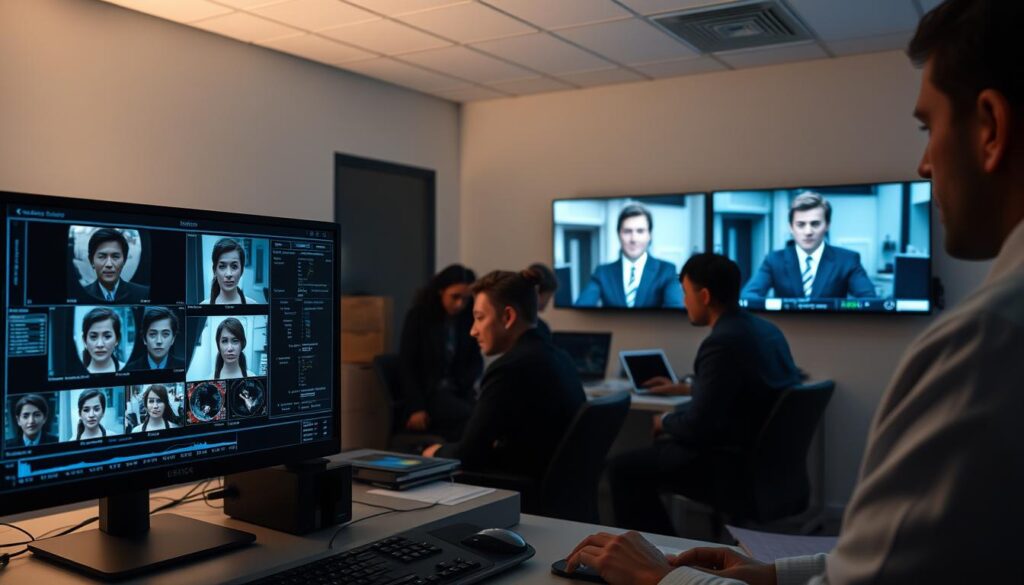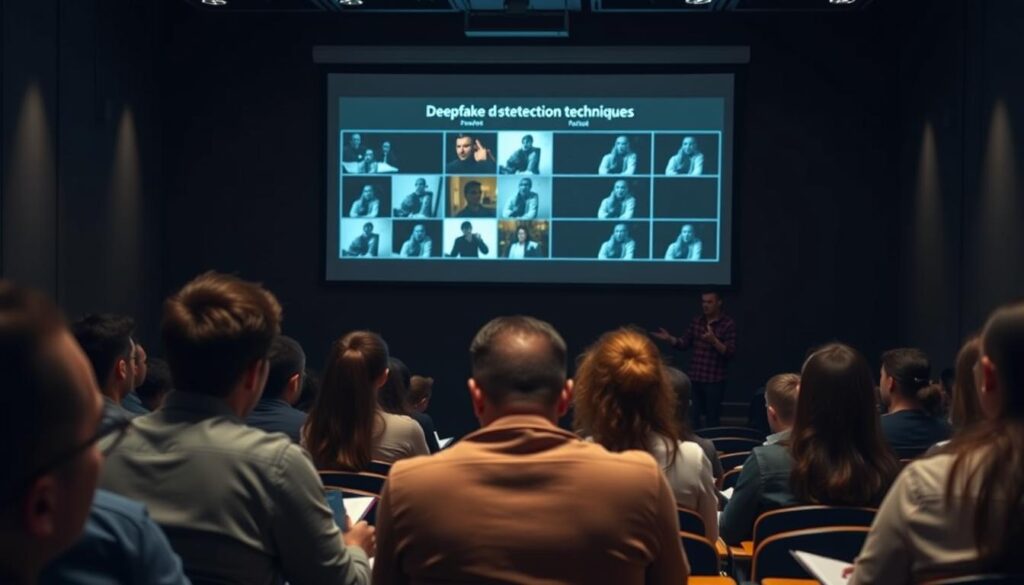We’re entering a time where it’s hard to tell real from fake. By 2025, deepfake technology has become alarmingly advanced — and easy to get. What started as fun has become a tool for sophisticated scams.
We need to know the danger these scams pose. The rise of deepfake technology means we must watch out for fake audio and video. This is to keep ourselves safe from these scams.
Key Takeaways
- Understand the basics of deepfake technology and its implications.
- Recognize the signs of deepfake scams.
- Learn how to protect yourself from deepfake scams.
- Stay informed about the latest developments in deepfake technology.
- Be cautious when consuming online content.
The Rising Threat of Deepfake Technology
Deepfake technology has grown from a fun tool to a serious threat. It was once used for entertainment but now scams people. We must learn to detect deepfake audio and video to stay safe.
From Entertainment to Criminal Tool
Deepfake technology quickly turned from fun to a criminal weapon. It was first used for laughs or to mimic celebrities. Now, it scams people by pretending to be important figures.
This change shows we need to be aware and know how to spot fakes. It’s a big deal.
Why Deepfakes Are More Dangerous in 2025
By 2025, deepfakes will be even more dangerous. They’re getting better and easier to make. This means scammers can trick more people.
With more online communication, deepfakes can harm us in many ways. We must get better at spotting fake digital content. It’s a race against time.
Understanding Deepfakes: What They Are and How They Work
Technology is changing fast, making it hard to tell what’s real and what’s not. Deepfakes are a type of fake media made with artificial intelligence (AI). They can create very convincing fake audio and video. It’s important to know how deepfakes work today.
The Technology Behind Synthetic Media
Synthetic media, like deepfakes, use advanced AI algorithms. These algorithms study and copy patterns in data, like voices or faces. The tech has gotten really good, making it hard to tell fakes from real stuff.
Deepfake tech relies on deep learning models, like Generative Adversarial Networks (GANs). GANs have two parts: one makes the fake, and the other checks if it looks real. This makes the fakes even more convincing.
How AI Creates Convincing Fakes
AI makes convincing fakes by learning from lots of data. For example, to make a deepfake video, AI is trained on many images and videos of a person. It learns to match their expressions and movements on another person’s face. This makes a very realistic video that looks like the real person.
AI can also change audio recordings to make fake voices. It analyzes a person’s speech patterns to create new audio that sounds like them. This is a big deal for keeping digital communications safe and trustworthy.
Common Deepfake Scam Scenarios You Should Know
Deepfakes are getting better at fooling people. It’s important to know when they’re used to trick us. They can mess with money or pretend to endorse products. Knowing these tricks helps us spot them.
CEO Fraud and Business Email Compromise
Deepfakes are a big problem in CEO fraud and BEC scams. Scammers pretend to be CEOs or top officials. They tell employees to send money or secrets. Always check who you’re talking to, not just their voice or face.
Family Emergency Impersonation Scams
Scammers also fake family emergencies. They use deepfakes to sound like a family member in trouble. They ask for money. Always call your family directly to check if it’s real.
Celebrity Endorsement Fraud
Deepfakes are used to fake celebrity endorsements too. Scammers make it seem like stars are promoting something. This can hurt the star’s image and trick fans. Be careful of too-good-to-be-true endorsements.
Knowing about these scams helps us stay safe. We need to keep learning how to spot them. Staying alert and updating our deepfake detection techniques is key.
Deepfake Scams Rising: Learn to Detect Fake Audio & Video Before You’re Fooled
Deepfake scams are on the rise, and we need to learn how to spot them. It’s important to stay alert, skeptical, and informed. This way, we can protect ourselves from falling into these scams.
Why Detection Skills Matter Now More Than Ever
In today’s world, deepfakes are getting very realistic. This makes it tough to tell what’s real and what’s not. Detection skills are key because they help us check if what we see or hear is true. By spotting deepfakes, we can stop spreading false information and keep ourselves safe.
To get better at spotting deepfakes, we need to know what to look for. Look out for unnatural movements or audio and video that don’t match. Keeping up with the latest deepfake tricks is also important, as scammers are always finding new ways to trick us.
The Psychological Tactics Scammers Use
Scammers use deepfakes to play on our emotions. They might try to scare or rush us into doing something. Knowing their tricks helps us resist their plans.
Being smart about unsolicited messages and checking who’s asking for help is important. Don’t make quick decisions when you’re feeling stressed. Being cautious is our best defense against deepfake scams.
Stopping deepfake scams takes a team effort. We need education, awareness, and new ways to detect them. By staying alert and working together, we can make the internet safer for everyone.
Video Deepfake Red Flags: Visual Clues to Watch For
Spotting deepfake videos needs a sharp eye and knowledge of warning signs. As these fakes get better, knowing visual clues is key to spotting them.
When checking videos, focus on a few key areas. Look at facial movements, lighting, and shadows, and watch for digital clues.
Unnatural Facial Movements and Expressions
Unnatural facial movements are a big sign of a deepfake. This includes:
- Infrequent or unnatural blinking
- Strange or stiff mouth movements
- Expressions that don’t quite match the context of the conversation
These signs can be small, so it’s important to watch closely.
Lighting and Shadow Inconsistencies
Lighting and shadow inconsistencies are another warning sign. Deepfakes often can’t get the lighting right. Look for:
| Inconsistency Type | Description | Example |
|---|---|---|
| Lighting Direction | Shadows falling in different directions | A face lit from one side, while the background is lit from another |
| Shadow Intensity | Shadows that are either too dark or too light compared to the surroundings | A person’s shadow is much darker than the shadows of other objects |
| Reflection Consistency | Reflections in glasses or other surfaces that don’t match the environment | A reflection in eyeglasses that doesn’t align with the lighting |
Digital Artifacts and Glitches
Lastly, digital artifacts and glitches are clear signs. These might show as:
- Distortions around the edges of the face or body
- Pixelation or blurring in certain areas
- Glitches or flickering in the video
Knowing these visual clues helps us spot deepfake videos. This way, we can avoid being tricked by fake content.
Audio Deepfake Detection: How to Spot Fake Voices

Deepfakes are getting better, making it key to spot fake voices. We’re bombarded with media, and knowing real from fake is essential. It’s a skill we all need to master.
To spot fake voices, we must understand natural speech. We should listen closely to audio for signs of trouble. By sharpening our listening, we can dodge scams and identify deepfake audio.
Unnatural Speech Patterns and Cadence
Unnatural speech patterns and cadence are big clues for deepfake audio. Real speech varies in tone, pace, and rhythm. Look out for robotic speech or a flat tone, as these hint at a deepfake.
Real voices have a natural flow and emotional depth. Deepfakes, on the other hand, might sound stiff or rehearsed. This difference is a key indicator.
Emotional Inconsistencies in Voice
Emotional inconsistencies in voice are another red flag. Human emotions are complex, and real speech shows this. Be cautious of audio that seems emotionally off or lacks depth.
For example, a calm voice during a serious topic might raise suspicions. This could be a sign of a deepfake.
Background Noise Analysis
Background noise analysis is also helpful. Real recordings have background noise that matches the setting. Look for odd changes in background sounds or unnatural silences.
Deepfakes often lack the background noises found in real recordings. This can help us spot them.
By focusing on these audio clues, we can better identify fake videos and audio. As deepfakes grow more common, learning to detect them is not just useful—it’s critical.
The Science of Deepfake Detection: Technical Approaches
To fight deepfake scams, we need to understand how to detect them. It’s not just about knowing they exist. We must use technology to stay ahead.
Several methods are being developed to spot deepfakes. These include AI-based detection tools and forensic analysis techniques. They are key in the fight against these scams.
AI-Based Detection Tools
AI tools use machine learning to find deepfakes. They learn from big datasets of real and fake videos. This helps them spot small differences.
AI tools are great because they can process lots of data fast. This is useful for quick checks in social media or video calls.
| Detection Method | Description | Advantages |
|---|---|---|
| Facial Expression Analysis | Analyzes the authenticity of facial expressions | Can detect subtle inconsistencies |
| Eye Movement Tracking | Monitors the natural movement of eyes | Effective against deepfakes with static eyes |
| Lip Syncing Analysis | Checks if the audio and video are synchronized | Identifies out-of-sync deepfakes |
Forensic Analysis Techniques
Forensic analysis looks at digital clues left by deepfakes. For example, checking video metadata can show tampering.
Another method looks at compression artifacts and noise patterns in files. Deepfakes often have unique digital signs that forensic analysis can find.
By mixing AI tools with forensic analysis, we can better detect deepfakes. As deepfake tech gets better, so will our detection methods.
Verification Protocols: Never Trust, Always Verify
In today’s world, it’s more important than ever to check who we’re talking to. With deepfake scams rising, we must use strong ways to make sure we’re not being tricked. This is key for keeping our personal and work lives safe.
It’s now vital to check identities through more than one way. This way, we’re not just trusting one source that could be fake. By using different ways to check, we lower the chance of falling for scams.
Establishing Secondary Communication Channels
One good way to check is by having extra ways to talk. If something seems off, don’t just trust what you’re told. Verify the identity of the person or group through another method. This could be calling a known number or checking with other trusted sources.
For example, if your CEO emails you asking for sensitive info, don’t just believe it. Call the CEO’s office on a number you know is real, not one in the email.
Creating Personal Verification Systems
Setting up your own checks is also key. This means making special questions or codes with people or groups you often talk to. These extra checks make it harder for fake people to trick you.
For example, you could make a deal with your bank. Agree on a special phrase or question to check if messages are real. If a message doesn’t have this, it’s probably a scam.
Using these checks helps keep us safe and builds a safer world. As we deal with deepfakes, being able to check and confirm information will be our best defense.
Real-World Case Studies: Deepfake Scams That Fooled Victims
Looking at real cases of deepfake scams shows how scammers trick people. These examples show how advanced deepfake tech is. They also stress the need to know how to spot fake audio and video.
The $25 Million Corporate Fraud Case
A big case involved a $25 million scam where deepfake tech was used. Scammers made the CEO’s voice to trick an employee into moving money. This shows how deepfake scams can cause big financial losses.
Key Takeaways:
- Deepfake audio was used to pretend to be a CEO.
- Always check financial requests through other ways.
How Ordinary People Lost Thousands to Voice Cloning
Scammers also use voice cloning to trick people out of thousands. They make a fake audio of a loved one in trouble, asking for money. People, thinking it’s real, send the money.
To stay safe, learn to detect deepfake audio. Pay attention to voice or message oddities.
By learning from these cases, we can fight back against deepfake scams. This helps protect us and our groups from fraud.
Protecting Your Digital Identity from Being Deepfaked
Deepfake technology is on the rise, and we need to act fast to protect our digital identities. With more of us using digital media, the danger of deepfakes growing. We must manage our online presence and keep our personal media and data safe.
Managing Your Online Presence
Being careful with what we share online is key. We should limit the amount of personal data we post. Also, adjust our privacy settings to keep our info safe.
It’s important to regularly check our online profiles. Remove any sensitive or harmful content we find.
Securing Personal Media and Data
Keeping our personal media and data safe is vital. Use strong, unique passwords for all accounts. Enable two-factor authentication and be careful with sensitive info or media.
Consider encrypting sensitive data. Also, keep your software and security systems updated to block unauthorized access.
Legal Recourse: What to Do If You’ve Been Targeted
If you’ve been a victim of a deepfake scam, it’s important to know your legal options. These scams can cause serious financial and personal harm. It’s key to understand how to respond effectively.
Reporting Procedures for Deepfake Scams
Reporting deepfake scams involves several steps. First, gather all evidence related to the scam. This includes any communications or transactions. Then, report the incident to the right authorities, like the Federal Trade Commission (FTC) or your local police.
| Reporting Channel | Description | Contact Information |
|---|---|---|
| Federal Trade Commission (FTC) | Report identity theft and online scams | FTC Complaint Assistant |
| Local Law Enforcement | Report crimes and get local guidance | 911 or local police department |
| Internet Crime Complaint Center (IC3) | Report internet-enabled crimes | IC3.gov |
Working with Law Enforcement
When working with law enforcement, provide as much detail as you can about the scam. Share any emails, messages, or financial records. This helps in investigating and possibly prosecuting the scammers.
By following the reporting procedures and working with law enforcement, victims can take big steps. They can lessen the damage and help bring the scammers to justice.
Teaching Others: Spreading Awareness in Your Community

As we deal with deepfake technology, it’s key to share its dangers in our communities. This helps others spot and dodge deepfake scams. It makes the digital world safer for all.
Being alert, skeptical, and informed is our strongest shield against deepfake scams. We need to know deepfake detection techniques and share this knowledge well. This is vital for those who might be tricked by scams.
How to Explain Deepfake Risks to Vulnerable Populations
When talking to the elderly or tech novices about deepfake risks, use easy words and examples they can relate to. Highlight the scams they might face and give tips to check if info is real.
For example, tell them deepfakes can look like family or authority figures. This helps them see the danger. Also, stress the need to check info through other sources before acting.
Creating a Culture of Healthy Skepticism
Building a culture of doubt is key against deepfake scams. Encourage people to doubt info that seems odd or too perfect. This cautious approach weakens deepfake scams.
Together, we can spread the word and teach deepfake detection techniques. This makes our community stronger against deepfakes.
The Future of Deepfakes: Staying Ahead of Evolving Threats
To fight deepfake threats, we must stay alert and informed. Deepfakes are here to stay, but we can outsmart them. Awareness is key to staying safe.
Understanding new technologies is vital to fight deepfake scams. These include:
- Improved AI algorithms: These make deepfakes look more real with less data.
- Real-time deepfake generation: Scammers can now make convincing deepfakes live.
- Enhanced audio and video quality: New tech makes deepfakes almost indistinguishable from real.
Emerging Deepfake Technologies
Deepfake tech is getting better fast. New methods are making synthetic media even more believable. Trends include:
- Deepfakes that perfectly mimic a person’s voice and mannerisms.
- Multimodal AI for deepfakes that mix audio, video, and text.
- Real-time deepfake generation for live chats.
Developing Detection Methods
To keep up with deepfakes, we need better ways to spot them. This includes:
- AI-powered detection tools for media analysis.
- Forensic analysis techniques to find deepfake clues.
- Behavioral analysis for spotting unusual patterns.
By knowing these new techs and improving detection, we can stop deepfake scams. This keeps us safe from these growing threats.
Building Digital Resilience in an Age of Synthetic Media
In today’s world, where fake content is common, being digitally resilient is vital. We must learn to spot deepfake content and know what’s real. This skill is essential as we deal with the digital world’s complexities.
Critical Thinking Skills for the Deepfake Era
Learning to think critically is a must in the deepfake age. It means looking at information without bias, checking who made it, and seeing different views. With better critical thinking, we can tell what’s real and avoid being fooled by fakes.
Balancing Skepticism with Trust
It’s important to be careful with what we see online but also trust some things. We shouldn’t doubt everything, but we should check if it’s true. Finding this balance helps us make smart choices based on solid facts.
Conclusion: Empowered Awareness Is Your Best Defense
Deepfake technology is complex, and knowing how to spot fake videos is key. Staying alert helps us protect ourselves and others from these scams.
We’ve learned to spot red flags in videos and audio. We’ve also discovered how to verify information to stay safe.
To dodge deepfake tricks, we must be careful and check facts from different sources. This way, we keep our digital world safe. Let’s keep sharing what we know and stay one step ahead of these threats.
Together, we can fight against fake videos and keep our trust in digital media strong.



